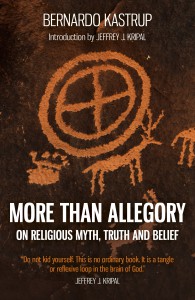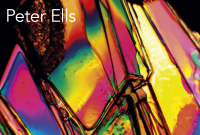
~ Rupert Spira
Publishing April 29th 2016
To mark the online availability of my new book More Than Allegory for pre-order (see links below), I am posting today the Overview
chapter of the book. You can now pre-order it here:
Buy Now Paperback: AMAZON US AMAZON UK INDIEBOUND
eBook Version available on Publication date
Overview
This book is a three-part journey into the rabbit hole we call the nature of reality. Its ultimate destination is a plausible, living validation of transcendence. Each of its three parts is like a turn of a spiral, exploring recurring ideas through the prisms of religious myth, truth and belief, respectively. With each turn, the book seeks to convey a more nuanced and complete understanding of the many facets of transcendence.
Part I will resonate especially with those who yearn for the richness that religious myths can bring into life, yet cannot get around the fact that these myths aren’t literally true. It tries to reach those whose souls are at war with their intellects. One of its goals is to restore the meaning of human life by helping the intellect give itself permission to accommodate the intuitions of the soul, without sacrificing reason or plausibility. Indeed, Part I puts forward the controversial notion that many religious myths are actually true; and not just allegorically so. It is the transcendent truth uniquely portrayed by these myths that our culture so desperately needs in order to understand the real. This transcendent truth, for not being amenable to words or equations, cannot be communicated through any other means—scientific or philosophical—but religious mythology. To make sense of all this, Part I attempts to articulate the nature of mythical truth in a manner that honors both religion and our skeptical rationality.
Part II pursues the next turn of the spiral by first taking a step back: while we all seek truth—be it through religion, science or philosophy—we very seldom inquire into the meaning of truth. What does it mean to say that something is true or false? What hidden assumptions do we make about the underlying nature of reality when we talk of truth? Tackling these questions is the journey of Part II. In its search for answers it leverages our direct experience of world and self to inquire into the nature of time and space, the framework where truth is supposedly to be found. It then concludes that our own inner storytelling plays a surprising role in creating the seeming concreteness of things and the tangibility of history. Finally, it points to clear echoes of its conclusions in many of the world’s religious myths.
Part III, as the final turn of spiral, is the pinnacle of this work. It brings all of the book’s core ideas together in the form of a modern, plausible religious myth. In laying out a complete cosmology for making sense of reality and restoring its transcendence, Part III highlights the critical role of belief in everything we take for granted. Indeed, it explains how deeply ingrained belief systems create the world we live in. Its narrative is based on the story of a modern explorer of consciousness who, during his participation in a secret scientific project, has a series of transcendent encounters. The metaphysics he brings back from these encounters integrates the themes of the book in one coherent framework. It also opens whole new horizons for the restoration of meaning and purpose to our daily lives.
Naturally, the optimal sequence to read this book is that in which it is presented: from Part I to Part III. Indeed, the ideas discussed in Parts I and II are meant to enrich the reading of Part III. That said, if one prefers to go straight to the heart of the matter and enjoy a gripping story without analytical preludes, it is entirely possible to jump directly to Part III and then return to Parts I and II afterwards.
In whichever order you choose to read it, you will notice that the three themes of this book—myth, truth and belief—flow into and interpenetrate each other at multiple levels and meta-levels throughout the text. Part I, for instance, examines mythology with a mindset characteristic of a quest for factual truth. Part II explores the nature of truth by appealing to our own felt intuitions, as we do when we pursue our beliefs. Finally, Part III elaborates upon the role of beliefs in the format of a myth. The goal is to illustrate, both explicitly and implicitly, through concepts and style, the intimate relationship that exists between myth, truth and belief.
The three parts of this book are meant to echo and reinforce each other content-wise as well. Its central ideas return in all three, being explored from a different angle each time. This allows me to convey—often indirectly and implicitly—many more nuances than otherwise possible. For instance, the nature and role of myth is explored in Part I, but the contents of certain myths come back in Parts II and III, where they echo what is discussed there about truth and belief.
The ebb and flow of the book’s trinity of themes ultimately circles around one of them: truth, the central motif of this work. All three parts revolve around it: Part I by exploring how myths can deliver truth, Part II by unveiling the nature of truth through dispelling unexamined beliefs, and Part III by appealing to belief in a myth in order to hint at truth.
You will notice that what I mean by the words ‘myth,’ ‘truth’ and ‘belief’ is richer and more nuanced than the flattened denotations of everyday language. This may, and probably will, surprise you at first. Nonetheless, the attempt to push the boundaries of words and reveal a much bigger, deeper reality behind them is an essential aspect of this work. My intent is to help you see beyond the dull, superficial cultural dialogue reigning in society today.
I hope you find many new vistas and avenues of inquiry in this book. I’ve poured much of myself into it; more than I think most authors would consider prudent. Whatever else it may or may not be, this work is most certainly a sincere, openhearted account of my own way to relate to life, the universe, truth and transcendence.
Author: Bernardo Kastrup has a Ph.D. in computer engineering with specializations in artificial intelligence and reconfigurable computing. He has worked as a scientist in some of the world's foremost research laboratories, including the European Organization for Nuclear Research (CERN) and the Philips Research Laboratories (where the "Casimir Effect" of Quantum Field Theory was discovered).
Bernardo has authored many scientific papers and five philosophy books: Rationalist Spirituality, Dreamed up Reality, Meaning in Absurdity, Why Materialism Is Baloney, and Brief Peeks Beyond. He has also been an entrepreneur and founder of a successful high-tech start-up. Next to a managerial position in the high-tech industry, Bernardo maintains a philosophy blog, an audio/video podcast, and continues to develop his ideas about the nature of reality. He has lived and worked in four different countries across continents, currently residing in the Netherlands.
Categories:
0 comments on this article











